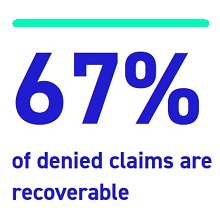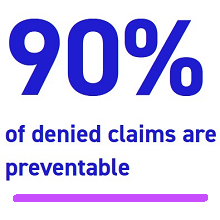Identifying the Acute Care Hospital Technical and/or Administrative Denial Reason
Posted on October 4, 2021
By Anthony Kolp and Cindy Betz
Writing Issue-Specific Appeals | Technical/Administrative | Identifying the Acute Care Hospital Technical and/or Administrative Denial Reason
By Cindy Betz and Tony Kolp | September 14, 2020
Identifying the Acute Care Hospital Technical and/or Administrative Denial Reason
As discussed in the introductory article, a technical or administrative denial occurs in the acute care hospital setting when a facility did not follow or was unable to follow the processes or policies outlined by the payer. Understanding and identifying the actual cause of the denial is imperative to successfully appealing a technical or administrative denial.
Denial Documentation
Facilities may receive notification of a technical or administrative denial via an explanation of benefits (EOB), remittance advice (RA), or a formal denial letter depending on the payer. Each of these documents provides important information regarding the cause of the denial.
- The EOB is a statement from the payer to the patient that describes the charges for medical care, including what the payer covered and anything that was denied.
- The RA is a similar statement to the provider/facility, identifying covered and non-covered charges. The RA provides additional information with a remark code that explains the reason for non-covered charges.
- The denial letter is a formal written notice to the member that explains the reason for denied services and outlines the member’s right to appeal the adverse determination.
There may be times the payer provides only a brief notification of the denial, such as through voicemail or fax. In these instances, an appeal writer should pursue an actual denial letter that specifies the reason(s) for denial and the appeal rights. The payer is required by the National Committee for Quality Assurance (NCQA) and sometimes payer contract to provide this information.
The facility’s patient accounting and utilization review documentation are also valuable sources of information to anyone drafting an appeal. These notes can provide specific information regarding communication between the payer and the facility, denied and approved inpatient days, and potential misinformation from the payer to the facility.
Identifying the denial reason
Understanding and identifying the reason for denial is crucial when appealing a technical or administrative denial. The EOB, RA, and denial letter all provide different avenues towards identifying the reason for denial. Cross-referencing between the denial letter and the RA, for example, may help the appeal writer determine the difference between a denial for lack of notification, characterized as “no auth” on the RA, but explained as “lack of medical necessity” in the denial letter. In this circumstance, the facility should appeal for the medical necessity versus the lack of authorization. Authorization was sought, just not obtained.
Technical and Administration Denial Language with Examples
| Case Study 1 |
| Issue: Lack of notification/pre-certification, or authorization of an admission |
| Scenario: Bob Smith presented to the facility on 8/24/2020 after experiencing progressively worsened shortness of breath (SOB). He was admitted as an inpatient with the diagnosis of acute COPD exacerbation. |
Facts: Bob Smith was unemployed and presented with no active insuranceBob Smith was screened and eligible for Medicaid coverage Retroactive Medicaid coverage beginning 8/1/2020 was obtained after discharge The claim was denied for lack of notification/precertification/authorization
Analysis: The facility was unable to notify the payer because coverage was not in place until after discharge. This denial requires an appeal for retrospective authorization to explain the extenuating circumstance that prevented timely notification of admission. |
| Example: Bob Smith presented to the hospital on 8/24/2020 with no active insurance on file as he was unemployed. The medical records indicated that the patient was screened and was eligible for Medicaid insurance coverage. Medicaid coverage was obtained and retroactively effective beginning on 8/1/2020. The facility could not make timely notification or request authorization during the admission as Bob Smith’s coverage was not obtained until after discharge. |
| Case study 2 |
| Issue: Failure to submit clinical after authorization obtained |
| Scenario: Mary Joe presented to the facility on 9/1/2020 after experiencing chest pain. She was admitted as an inpatient with acute myocardial infarction (MI). |
Facts: Authorization for one inpatient day was obtained on 9/1/2020, with authorization # 1234567. The authorization fax approval instructed the facility to submit updated clinical for the next review via their payer portal on 9/2/2020. On 9/2/2020, the facility attempted to submit updated clinical via the payer’s online portal. An error message was obtained and the clinical was unable to be uploaded after multiple attempts. On 9/3/2020, Mary Joe discharged from the hospital. On 9/3/2020, the facility received a denial for lack of clinical.
Analysis: The facility was unable to submit updated clinical on 9/2/2020 as the payer’s online portal was down. A technology failure was an extenuating circumstance that could be supported within an appeal. |
| Example: Mary Joe Smith presented to the facility on 9/1/2020 and was admitted as an inpatient with acute MI. Authorization for one inpatient day was obtained on 9/1/2020, with authorization #1234567. An authorization fax approval from the payer was received by the facility with instructions to submit updated clinical for the next review via their payer portal on 9/2/2020. On 9/2/2020, the facility attempted to submit updated clinical via the payer’s online portal. An error message was obtained, and the clinical was unable to be uploaded after multiple attempts. Due to the technology failure, the facility was unable to provide the clinical update and requested retrospective continued stay for 9/2/2020. |
The First Step in the Appeal Process
The ability to correctly recognize the denial reason at hand is the first step in the appeal process. If the denial reason is unclear, utilizing other resources such as patient accounting or utilization review documentation is often helpful. Resources at an appeal writer’s disposal encompass all-payer documentation and communication, including telephone, fax, email, and portal responses. Knowledge of the payer’s authorization expectations and requirements, including criteria for extenuating circumstances, is key to constructing a successful appeal.
|




